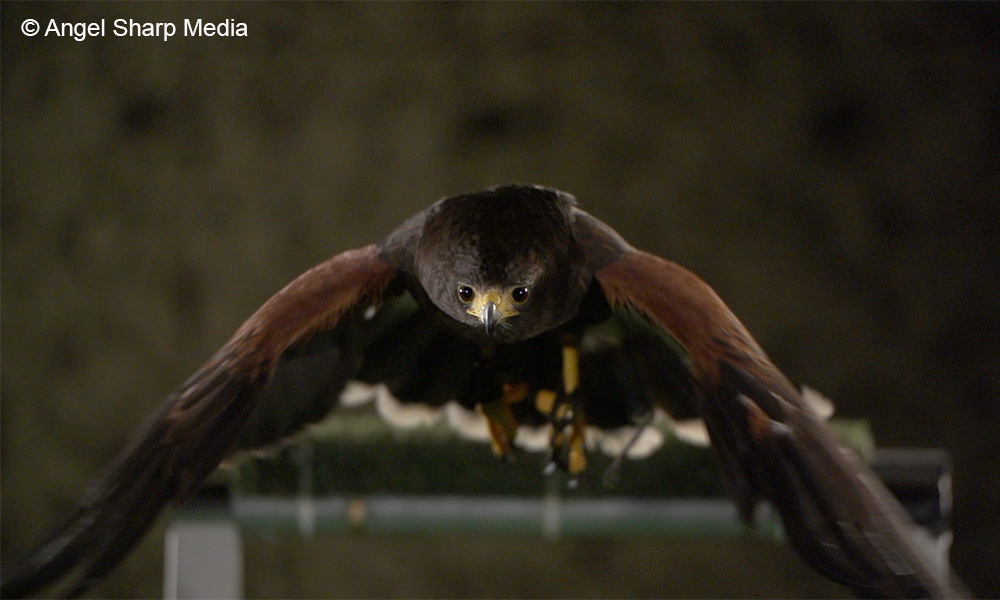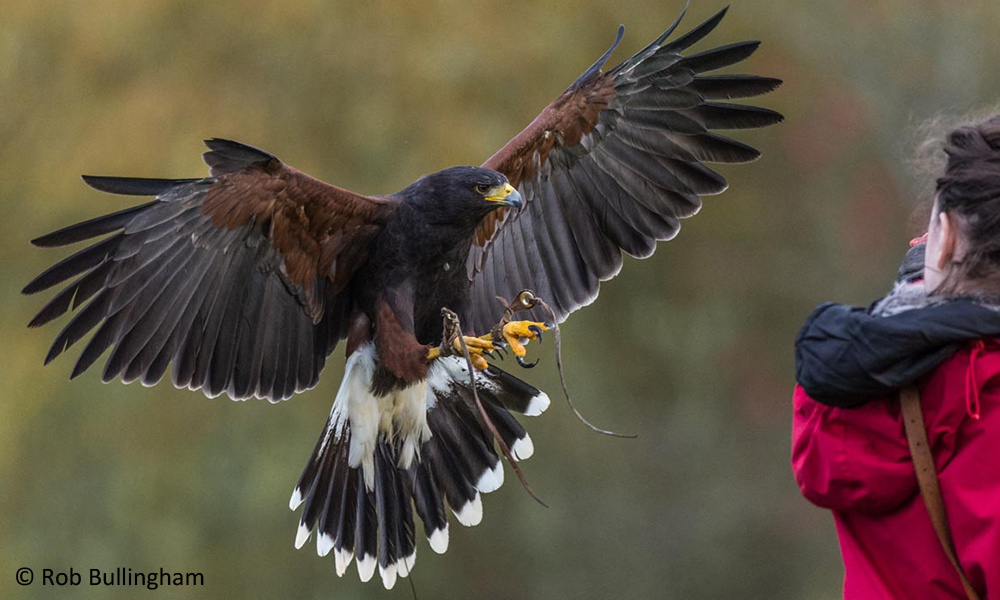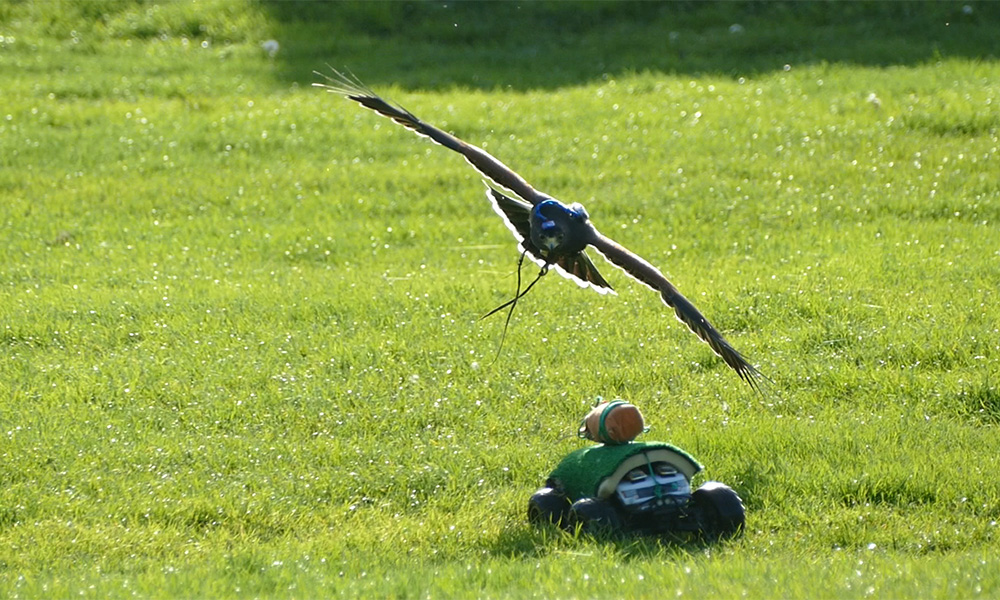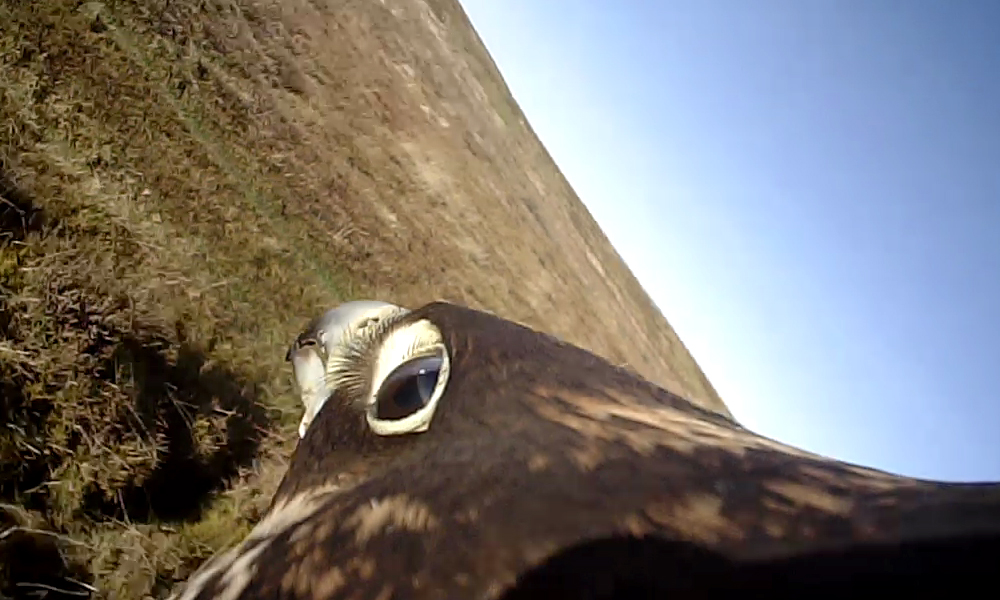

A selection of media coverage of our more recent work.

BBC Wildlife Magazine. 18 January 2025. From the team behind Secret World of Sound with David Attenborough and Attenborough and the Giant Elephant, a new TV series takes to the skies to show a different perspective on animal behaviour.... [read on]

Quanta Magazine. 3 August 2022. In a rectangular room draped in camouflage netting, four Harris’ hawks took turns flying back and forth between grass-covered perches while scientists recorded their every biomechanical flutter.... [read on]

New Scientist. 29 June 2022. A diving manoeuvre used by raptors to slow down before landing on a branch could improve technology for flying and perching drones... [read on]

Horizon Magazine, EU. 1 June 2021. A bird flaps its wings, glides using air currents and then smoothly descends to perch on a pole. But this is not just any bird, it’s a robot bird. And robots like these could in the next decade be used to respond to emergencies or to hunt down drones posing a threat to safety or security... [read on]

iNews, UK. 11 June 2019. The flight trajectory of hawks could help to inform future drones designed to chase and hunt down fellow unmanned aerial vehicles, a study suggests... [read on]
Washington Post, USA. 12 April 2018. Peregrine falcons, apex predators that hunt near rock cliffs and skyscrapers, strike like a stock market crash: fast and hard. The birds fly to great heights, then tuck their wings and plummet... [read on]
National Audubon Society, USA. 13 April 2018. When it comes to hunting on the fly, nothing beats the Peregrine Falcon. By folding its wings in to minimize drag, the boomerang-shaped birds can hurtle thousands of feet through the air at speeds of close to 200 miles per hour... [read on]

National Public Radio, USA. 4 December 2017. Peregrine falcons, known for making spectacular dives to snatch smaller birds midair, conduct their aerial assaults in much the same way that military missiles hit moving targets... [read on]

Business Insider, UK. 19 April 2017. Scientists have solved the mystery of mosquito flight using super high-speed cameras and computer analysis to understand the unique mechanisms the insect uses to stay airborne... [read on]
Videos and podcasts illustrating and explaining some of our research.
Airborne, Sky Nature. 29 December 2024 This visually stunning series celebrates the unique challenges and ultimate freedom of animals that use the air to survive and thrive. Produced by Humble Bee Films with Professor Graham taylor as series consultant, Airborne gives viewers a true bird’s-eye view from airborne birds and animals as they catch air for the first time, snatch in-flight meals, navigate crowded skies and soar through the most challenging environments on the planet. [watch here]

Curious Cases. BBC Radio 4, UK. 28 December 2024. Hannah Fry and Dara Ó Briain want to know what is the fastest fly. Could a claim horseflies reach speeds of up to 90 mph possibly be true? For Professor Graham Taylor the question of speed comes down to a simple calculation, and the team try to work out whether a horsefly beats its wings fast enough relative to its size to travel so rapidly. He explains horseflies aren't clever, but scientists are interested in their simple brains and are studying them to use as models for drones and mini robots. [listen here]
The Laboratory with Leaves, UK. 23 May 2019. Flight is perhaps the most complex form of movement in the animal kingdom. Researchers at Oxford’s Wytham Woods are looking at exactly how it works, while branching out into how birds perch. [watch here]
Tumble Science Podcast. 18 October 2019. How do peregrine falcons dive so fast? That’s what Tumble science podcast listener Henry wants to know... [listen here]
Oxford, UK. 12 March 2019. Planthopper bugs may be small, but they attract mates from afar by sending vibrational calls along plant stems and leaves using fast, rhythmic motions of their abdomen.

More or Less. BBC Radio 4, UK. 24 August 2018. What would have been the most efficient way to get to Mordor, and how fast would Tolkien's Great Eagles, Gwaihir and Thorondor, have flown? To answer this Tim Harford turns to information in the Lord of the Rings books, and original documents at the Tolkien exhibition at the Bodleian Libraries in Oxford. He crunches the numbers with the help of Professor Graham Taylor of Oxford University. [listen here]
Dr Simon Walker explains his research on the aerodynamics of mosquito flight. Video produced by Inés Dawson.

BBC World Service, UK. 7 December 2017. By analysing how a peregrine falcon chases its prey in flight, scientists have discovered that they track their prey in the same way as tracking missiles lock on to their target. This clever way of hunting on the wing is now being copied and applied to drone technology, as a way of making drone-hunting drones to try and thwart the growing number of crimes committed by these flying machines... [listen here]
Oxford, 23 August 2022.
A study published this week in Nature Communications shows how hunting hawks solve the problem of intercepting a single bat within a dense swarm. The findings increase our understanding of how predators select and track a target among thousands of potential prey.
The research was undertaken by Dr Caroline Brighton, a post-doc with the Oxford Flight Group in the Department of Biology at the University of Oxford, alongside colleagues from the University of New Hampshire. The researchers observed Swainson’s Hawks (Buteo swainsoni) and other raptors hunting a colony of approximately 700,000 to 900,000 Mexican Free-tailed Bats (Tadarida brasiliensis) as the bats emerged from a cave each evening. By using an array of cameras, they were able to reconstruct the 3D flight trajectories of the raptors and bats, which they analysed computationally.
It is generally thought that being in a large group — such as a swarm of bats, a flock of birds, or a school of fish — provides protection from predators. One way in which this protection could arise is through a ‘confusion effect’: the presence of many potential targets may confuse predators, making it more difficult for them to focus on and capture a specific individual. If predators get confused, then they should become less successful at catching prey as the prey’s group size increases. However, empirical evidence for a confusion effect has been mixed.
To understand more about the confusion effect, the researchers headed to a remote study site in the Chihuahuan Desert in New Mexico, USA. The site is located on a vast volcanic plateau approximately 1500m above sea level, where the remains of lava tubes form deep caves which the bats use as a day roost during their breeding season. The bats stream out at dusk in a continuous ribbon to fly to their feeding grounds. The predictability and regularity of the behaviours make it an excellent study system.
By pairing two cameras in stereo, Dr Brighton and colleagues filmed hawks hunting the bats as they emerged at dusk. They then reconstructed the hawks’ flight paths in 3D and compared the trajectories of the real birds with the trajectories modelled by a computer algorithm.
The researchers found that, instead of continuously targeting an individual bat, the hawks would steer towards a fixed point within the swarm. This still begs the question of how the hawks selected which targets to grab. However, as any bat on a collision course with the hawk would appear to remain on a constant bearing the hawks may use this to single out a target bat from the swarm. Dr Brighton explains:
‘From the viewpoint of a stationary observer – such as a person stood on the ground - all members of the swarm appear to move erratically. For a mobile observer – like the hunting hawks in flight - any bat that it is on a collision course with it will appear stationary against the background movement of the swarm’
The authors suggest that this strategy of targeting a fixed point in a group of prey may be a more general mechanism yet to be discovered in other predators. However, they indicate it may only be effective when prey aggregations are sufficiently dense.
‘Our work shows how the appearance of a swarm depends on the predator’s own motion, so starling murmurations and many other group behaviours that look bewildering to our own eyes may not appear so confusing to a predator taking the plunge.’ said Professor Graham Taylor, senior author of the study and leader of the Oxford Flight Group. ‘The same will hold true for other agents using visual targeting of swarms, including drones and other autonomous vehicles.’
This project has received funding from the European Research Council (ERC) under the European Union’s Horizon 2020 research and innovation programme (Grant Agreement No. 682501).
Oxford, 30 June 2022.
New research from the Oxford Flight Group using computer simulations and Hollywood-style motion capture shows how birds optimise their landing manoeuvres for an accurate descent.
Researchers at the University of Oxford have found that hawks control their flight to ensure the safest landing conditions when perching, even if it takes longer and more energy to do so. Understanding how birds optimise their landing manoeuvres through learning may help in developing small aircraft capable of perching like birds.
In new research published in Nature, four Harris’ hawks wearing tiny retroreflective markers were tracked flying back and forth between two perches. Their precise movements were recorded by 20 motion capture cameras positioned around the room, allowing the research team to reconstruct their flight paths on over 1,500 flights. The research team then used computer simulations to understand why the birds chose their particular path to the perch.
Aircraft have the luxury of using a runway for braking after landing to reduce speed. In contrast, birds must brake before they arrive at the perch – however slowing down to a safe speed while in flight risks stall, leading to a sudden loss of flight control. The researchers discovered that the hawks follow a flight path that slows them down to a safe speed but minimises the distance from the perch at which they stall.
To minimise stall, the hawks dived downwards while flapping, before spreading their wings into a gliding posture as they swooped up to the perch. By selecting just the right speed and position from which to swoop up to the perch, the birds were already within grabbing distance of the perch when they stalled, keeping their landings as safe and controllable as possible.
Co-lead author Dr Lydia France, Department of Biology, University of Oxford said: ’We found that our birds weren’t optimising either the time or energy spent, so their swooping trajectories were neither the shortest nor cheapest options for getting from A to B. Instead, our birds were reducing the distance from the perch at which they stalled and were even better at limiting stall than our simplified computer model.’
‘The three juvenile birds flew directly between the perches by flapping for the first few flights of their familiarisation period but soon adopted the indirect swooping behaviour characteristic of experienced birds,’ explained co-lead author Dr Marco KleinHeerenbrink, Department of Biology, University of Oxford.
Landing is a critical manoeuvre, and stalling has been the cause of many aircraft accidents. Looking at birds and asking how they solve the problem of safe landing might help us find new bioinspired design solutions for our own technologies, including small aircraft capable of perching like birds.
Understanding how birds learn complex motor tasks like landing might also help improve artificial intelligence (AI). When aircraft engineers use computers to solve the problem of perching using a trial-and-error approach to refine the data, it can take tens of hundreds of hours to find an answer. Yet, hawks find an optimised solution over a handful of flights, showing the gap that still exists between natural and artificial intelligence.
‘Motion capture technology has allowed us to analyse thousands of flights at a time, tackling questions that we never could have done before. Looking forward, this opens the tantalising possibility of understanding how animals learn complex motor tasks, like learning to fly, and of revolutionising how robotic systems can do the same,’ said senior author Professor Graham Taylor.
This project has received funding from the European Research Council (ERC) under the European Union’s Horizon 2020 research and innovation programme (Grant Agreement No. 682501).
Oxford, 11 June 2019.
Hawks steer their pursuit of evasive prey using a feedback system that differs fundamentally from the missile-like interception system of falcons, according to a new study led by scientists at the University of Oxford, Department of Zoology, published today in Nature Communications. This mixed guidance law allows hawks to pursue agile prey through cluttered habitats without being thrown off the pursuit by the prey’s erratic escape manoeuvres.
Previous research has shown that falcons intercept prey using the same guidance law as homing missiles, called proportional navigation. This guidance law is optimal against smoothly-manoeuvring aerial targets, but is prone to being thrown off by the zigzagging manoeuvres of terrestrial prey like hares or jackrabbits, and will not necessarily lead to a feasible flight path through the cluttered habitats that hawks frequent.
University of Oxford researchers, Dr Caroline Brighton and Prof Graham Taylor, used high-speed cameras to capture the flight trajectories of five captive-bred Harris’ Hawks during 50 flights against an erratically-manoeuvring artificial target.
Dr Brighton said: ‘We filmed our hawks flying after a dummy bunny, which was an artificial target that we towed at speed around a series of pulleys laid out to produce an unpredictable course. Using video reconstruction techniques to measure the 3D trajectory of the hawk and its target, we then ran a computer simulation to see how closely the hawk’s attack behaviour was modelled by different kinds of guidance law.’
The researchers found that Harris’ Hawks use a mixed guidance law, in which their turn rate is determined by feeding back information on the angle between the direction to their target and their current flight direction, together with information on the rate at which the direction to their target is changing. The researchers argue that this mixed guidance law reduces the risk of overshoot in the close pursuits to which hawks are adapted, but would produce an inefficient flight path if used in the long-range interception behaviours of falcons.
The findings have applications to the design of drones for pursuing and capturing rogue drones in cluttered environments.
Prof Taylor said: ‘Last year's Gatwick incident showed just how far we are from being able to remove rogue drones quickly and safely from a large open space, let alone the cluttered airspace of an urban environment. Hawks are masters of close pursuit through clutter, so we think they have a thing or two to teach us about how to design a new kind of drone that can safely chase down another.’
This project has received funding from the European Research Council (ERC) under the European Union’s Horizon 2020 research and innovation programme (Grant Agreement No. 682501).
Oxford, 13 March 2019.
Planthopper bugs may be small, but they attract mates from afar by sending vibrational calls along plant stems and leaves using fast, rhythmic motions of their abdomen.
Researchers at the University of Oxford describe how a newly-discovered “snapping organ” enables courting bugs of both sexes to produce this shaking motion through a combination of muscle action and elastic recoil.
Published in the open-access journal PLOS Biology, the study highlights how small animals can communicate at a distance despite the constraints of small body size.
Producing vibrations that will travel well along plant material requires the sudden release of mechanical energy – many times faster than could be achieved through direct action of the planthoppers’ tiny muscles.
The secret lies in the fast release of stored elastic energy, rather like a catapult, but with the key difference that the stored energy is released cyclically, leading to a repetitive up-down motion of the abdomen. This is accomplished by a complex anatomical structure that the researchers call the “snapping organ”, because of the speed with which it snaps open and closed.
The discovery of the new organ was as unexpected as its mechanism. Lead author from the Department of Zoology, Leonidas-Romanos Davranoglou, said: ‘I was studying 3D images of planthoppers that I had collected using X-ray imaging in a particle accelerator, trying to understand the evolutionary relationships between different groups. But as I dissected the bugs in virtual reality on my computer, I immediately realised that I was looking at something entirely new, so decided to investigate further.’
Researchers collected hundreds of live planthoppers from the hills around Athens, which they brought back to their Oxford lab to conduct experiments. To understand the vibration generation mechanism of the new snapping organ, they used microtomography, laser vibrometry, confocal microscopy, and high-speed video recordings.
The scientists then teamed up with the University of Oxford’s Department of Engineering Science to build a mathematical model of the mechanism. The vibratory organ was found to be present in all of the many different families of planthoppers, showing that this entire group of bugs are specialists in this unusual form of communication.
Senior author Dr Beth Mortimer, Department of Zoology, said: ‘These insects include several economically important pest species, including the brown planthopper, which is one of the most serious pests on rice in the developing world. Understanding how these insects signal to each other may help in disrupting their communication channels or detecting their calls.
‘Silent to the ear, the planthoppers have come up with their own novel way to communicate with potential mates. You could say it’s their form of snap chat.’
While the discovery of the snapping organ is new, the method is an extremely old mechanism of communication, dating back at least 250 million years, to the dawn of planthopper evolution.Oxford, 12 April 2018.
Researchers at Oxford University have discovered that peregrine falcons steer their attacks using the same control strategies as guided missiles.
Computer simulations of peregrine falcon attacks show that the extreme speeds reached during dives from high altitudes enhance the raptors’ ability to execute maneuvers needed to nab agile prey that would otherwise escape. Robin Mills and colleagues of the University of Groningen, Netherlands, and Oxford University, UK, report this discovery in PLOS Computational Biology.
By attaching video cameras and GPS trackers on a Peregrine falcon, prior research by the team showed that falcons attack their prey using the same steering rules as man-made missiles. But it remained unknown why peregrine falcons choose to catch prey by diving from great heights at speeds faster than any other animal. Such risky behavior surely places extraordinary physical and cognitive demands on the falcon.
To investigate the peregrine’s dive strategy, Mills and colleagues built a physics-based computer simulation of bird flight that pits falcons against prey. The simulation incorporates the aerodynamics of bird flight, how birds flap and tuck their wings, how falcons perceive their prey and react to it with delay and how falcons target their prey like a missile.
By running the simulation millions of times, varying the falcon’s attack strategy each time, the researchers showed that high-speed dives enable peregrines to produce much higher aerodynamic forces for maneuvering, thereby maximizing their chance of seizing agile prey.
Still, the simulation showed, high-speed dives require very precisely tuned steering for a falcon to attack successfully, revealing that the stoop is a highly specialist hunting technique. The research team found that optimal tuning of the mathematical laws that control steering in the simulation corresponded closely to measurements of steering for real falcons.
The research team is now extending their simulation to explore why different raptor species, including the goshawk and the sparrow hawk, have unique attack strategies, and to identify why different raptors often specialize on different types of prey. They are also studying the best escape tactics that prey can employ to evade capture.
“Our simulations reveal why peregrines have evolved to dive from great heights, and at speeds faster than any other animal,” Mills says. “Ultimately, we aim to understand the arms race between aerial predators and their prey that has led raptors to become some of the fastest and most agile animals on Earth.”
Oxford, 4 December 2017.
Researchers at Oxford University have discovered that peregrine falcons steer their attacks using the same control strategies as guided missiles.
The findings, which overturn previous assumptions that peregrines' aerial hunting follows simple geometric rules, could be applied to the design of small, visually guided drones that can take down other 'rogue' drones in settings such as airports or prisons.
The research, initially funded by the US Air Force Research Laboratory and published open access in the journal PNAS, may also give scientists greater insight into the pursuit behaviours of other predatory species – in the air, in water, or on the ground.
Principal investigator Professor Graham Taylor, of the Oxford Flight Group in Oxford University's Department of Zoology, said: 'Falcons are classic aerial predators, synonymous with agility and speed. Our GPS tracks and on-board videos show how peregrine falcons intercept moving targets that don't want to be caught. Remarkably, it turns out that they do this in a similar way to most guided missiles. Our next step is to apply this research to designing a new kind of visually guided drone, able to remove rogue drones safely from the vicinity of airports, prisons and other no-fly zones.'
The Oxford researchers used miniature GPS receivers to track peregrines attacking dummy targets thrown by a falconer or towed by a drone and were able to apply a mathematical simulation to these movements describing the dynamics of the guidance system used in intercepting the dummy prey.
The researchers collected on-board video giving a falcon’s-eye view of the attacks and used this to back up their conclusions. Remarkably, they found that the terminal attack trajectories of peregrines follow the same law – known as proportional navigation (PN) – used by visually guided missiles, but with a tuning appropriate to their lower flight speed. This method does not require any information on a target's speed or distance, instead relying simply on information about the rotation of the attacker's line of sight to the target.
The researchers conclude that PN guidance optimised for low flight speeds could find use in small, visually guided drones designed to remove other drones from protected airspace. Recent publicity has revealed the growing problem of drones flying drugs and mobile phones into prisons, and of drones being flown in the vicinity of airports.
Co-author Dr Caroline Brighton, from Oxford's Department of Zoology, said: 'We spent four field seasons flying falcons in the Welsh hills, working with an experienced falconer and a qualified drone pilot. It was very exciting to study these sleek, formidable aerial predators, and to watch them as they chased down our manoeuvring lure towed behind a small remote-controlled airplane – then, through our computer modelling, to reveal the secret of their attack strategy.'